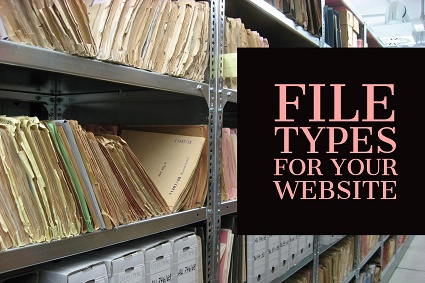Your cart is currently empty!

File Types for Your Website
Your website is so far beyond your company brochure or magazine ad! You can add a wide range of media and provide a multisensory experience for your visitors. But how do you get your media onto the web page? It all comes down to file types.
When you save a file, it will have an extension after its name. Check out some of the files you have on your desktop or document storage, and you’ll see things like .docx, .jpg, .pdf, and maybe .html, .mp3, or .ai. When you want to add content to your website, you need to send your web team the right kind of file for the right purpose.
Web pages
Web pages (and posts, if you’re using WordPress) are the basics for your website. If there’s no reason to use another type of file, this is what you should use. Your primary content should be web pages. In the past, some web pages were actually pictures. If you have that going on at your website now, you’re missing out on the value of the modern web. Your web team will typically build these files; you will rarely send them to your web team.
Pictures
Your web team will usually say “image” when discussing pictures. We’re going to go with that. Broadly speaking, you should use .jpg for photographs. You should use .png when you have an image that has transparent parts — your logo, for example. You don’t want your logo to show up with a white rim around it, so you’ll send a .png image.
If you have a vector image, you should send that. Vector images can be made bigger or smaller without losing quality. Files with .eps and .ai will be vector files.
Send a .gif only if you want an animated image. Send a .pdf only if you have no other choice. We’ll talk more about pdf files in the next section.
Printable documents
When you want to print a document out, a .pdf file is your best option. We put PDFs on web pages when we want visitors to be able to print out a patient form, an e-book or a research document such as a letter or a historical document of some kind.
The first link below is a PDF file. If you click on it, it will take you to the PDF. The second link is a .jpg file — a picture of the PDF once it has been printed out. The .pdf file has pictures in it, but it is much more readable and easier to print well than a .jpg of a document would be. If you print out the .jpg, you won’t be able to read it easily. On the other hand, the link to the .pdf file isn’t very visually interesting.

We might use a text link to a PDF, like, “Download the full article,” or we might use a picture of the PDF. The PDF is to be downloaded and printed out or read on a screen.
Video
If you have the option of uploading your video to YouTube or another similar service and embedding it in your web page, you should do that. Your web team may be able to help you out.
You can upload a video file, such as .mp4, .avi, or .wmv, but it will take up a lot of bandwidth. Sometimes website owners want to upload videos instead of using a video service like YouTube for the sake of privacy or control, but there is very little value to that for a professional website. You want people to see your video. You’ll also get analytics that way.
Audio
Audio file types include .wav and .mp3, among others. If you want to create a podcast or showcase your musical stylings, think about using a service, for the same reasons that you’d use a service for videos. However, a quick MP3 for the occasional post can work very well. Most web teams we know prefer .mp3.
by
Tags:

Leave a Reply